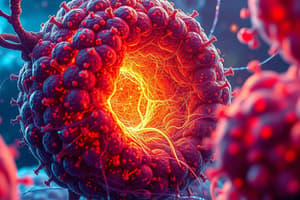Podcast
Questions and Answers
What is the primary role of vaccines in the immune system?
What is the primary role of vaccines in the immune system?
- To destroy pathogens directly
- To enhance the effectiveness of white blood cells
- To provide immediate immunity
- To introduce weakened or inactive pathogens (correct)
Which of the following is NOT a factor affecting photosynthesis?
Which of the following is NOT a factor affecting photosynthesis?
- Water availability
- Carbon dioxide concentration
- Sunlight intensity
- Sound frequency (correct)
What distinguishes anaerobic respiration from aerobic respiration?
What distinguishes anaerobic respiration from aerobic respiration?
- It produces more energy
- It generates more carbon dioxide
- It does not require oxygen (correct)
- It occurs only in plants
What component of the immune system produces antibodies?
What component of the immune system produces antibodies?
What is a major consequence of oxygen debt experienced during strenuous exercise?
What is a major consequence of oxygen debt experienced during strenuous exercise?
What is the primary difference between eukaryotic and prokaryotic cells?
What is the primary difference between eukaryotic and prokaryotic cells?
Which process requires energy to move substances against their concentration gradient?
Which process requires energy to move substances against their concentration gradient?
What type of microscope provides the highest magnification and resolution?
What type of microscope provides the highest magnification and resolution?
Which of the following cells perform specific functions and are specialized?
Which of the following cells perform specific functions and are specialized?
What is the main role of xylem in a plant?
What is the main role of xylem in a plant?
What describes the interaction between an enzyme and its substrate?
What describes the interaction between an enzyme and its substrate?
Which type of pathogen is responsible for communicable diseases?
Which type of pathogen is responsible for communicable diseases?
Which vessels carry deoxygenated blood back to the heart?
Which vessels carry deoxygenated blood back to the heart?
Flashcards
Immune System
Immune System
The body's natural protection against pathogens, involving three lines of defense: physical barriers, phagocytosis, and antibody production.
Photosynthesis
Photosynthesis
The process by which plants convert light energy into chemical energy in the form of glucose, using carbon dioxide and water.
Respiration
Respiration
The breakdown of glucose to release energy, with the presence of oxygen (aerobic) or without (anaerobic).
Oxygen Debt
Oxygen Debt
Signup and view all the flashcards
Phagocytosis
Phagocytosis
Signup and view all the flashcards
Eukaryotic cells
Eukaryotic cells
Signup and view all the flashcards
Prokaryotic cells
Prokaryotic cells
Signup and view all the flashcards
Mitosis
Mitosis
Signup and view all the flashcards
Passive transport
Passive transport
Signup and view all the flashcards
Active transport
Active transport
Signup and view all the flashcards
Enzymes
Enzymes
Signup and view all the flashcards
Lock and key model
Lock and key model
Signup and view all the flashcards
Communicable disease
Communicable disease
Signup and view all the flashcards
Study Notes
Cell Biology
- Two main types of cells: eukaryotic and prokaryotic
- Eukaryotic cells further divided into plant and animal cells
- Prokaryotic cells include bacterial cells
- Light microscope, common in GCSE biology
- Magnification formula:
magnification = image size / actual size - Electron microscopes provide higher magnification and resolution than light microscopes
- Stem cells are undifferentiated cells with potential to specialize
- Specialized cells adapted for specific functions (e.g., nerve, sperm, egg, brain, muscle cells)
- Mitosis is cell division creating two identical daughter cells
- Mitosis crucial for growth processes like root and shoot development
- Diffusion and osmosis are passive transport processes (high to low concentration)
- Active transport is an active process (low to high concentration, requiring energy)
Organization
- Cells form tissues, tissues form organs, organs form organ systems
- Enzymes are biological catalysts, speeding up chemical reactions
- Lock and key model describes enzyme-substrate interaction
- Key digestive enzymes: protease, carbohydrase, lipase
- Digestive system includes mouth, esophagus, stomach, small intestine, large intestine, and rectum
- Circulatory system consists of heart and blood
- Heart has four chambers (left and right atria, left and right ventricles) connected by four blood vessels
- Arteries carry oxygenated blood away from the heart
- Veins carry deoxygenated blood back to the heart
- Capillaries facilitate substance exchange between blood and tissues
- Plant organization involves leaf structure, xylem, and phloem
- Xylem transports water from roots through transpiration
- Phloem transports food up and down the plant through translocation
Infection and Response
- Communicable diseases spread from person to person
- Four main pathogen types: bacteria, protists, fungi, viruses
- Pathogens spread via air, direct contact, or water
- Hygiene, self-isolation, and vaccination prevent disease spread
- Body's immune system has three lines of defense against pathogens
- First line of defense: physical barriers (skin, hairs, mucus, stomach acid)
- Second line of defense: phagocytosis by white blood cells
- Third line of defense: lymphocytes produce antibodies and memory cells
- Vaccines introduce weakened/inactive pathogens to stimulate immune system
- Drug development ensures a new drug's safety and efficacy before public use
Bioenergetics
- Photosynthesis converts light energy to chemical energy
- Photosynthesis equation:
6CO2 + 6H2O -> C6H12O6 + 6O2 - Factors affecting photosynthesis: CO2 concentration, water, temperature, sunlight intensity, chlorophyll
- Respiration breaks down glucose to release energy
- Respiration equation:
C6H12O6 + 6O2 -> 6CO2 + 6H2O + energy - Metabolism encompasses all chemical reactions in the body
- Aerobic respiration requires oxygen, producing CO2 and water
- Anaerobic respiration occurs without oxygen, producing lactic acid or ethanol
- Oxygen debt occurs during strenuous exercise, repaying oxygen used during anaerobic respiration
Studying That Suits You
Use AI to generate personalized quizzes and flashcards to suit your learning preferences.




